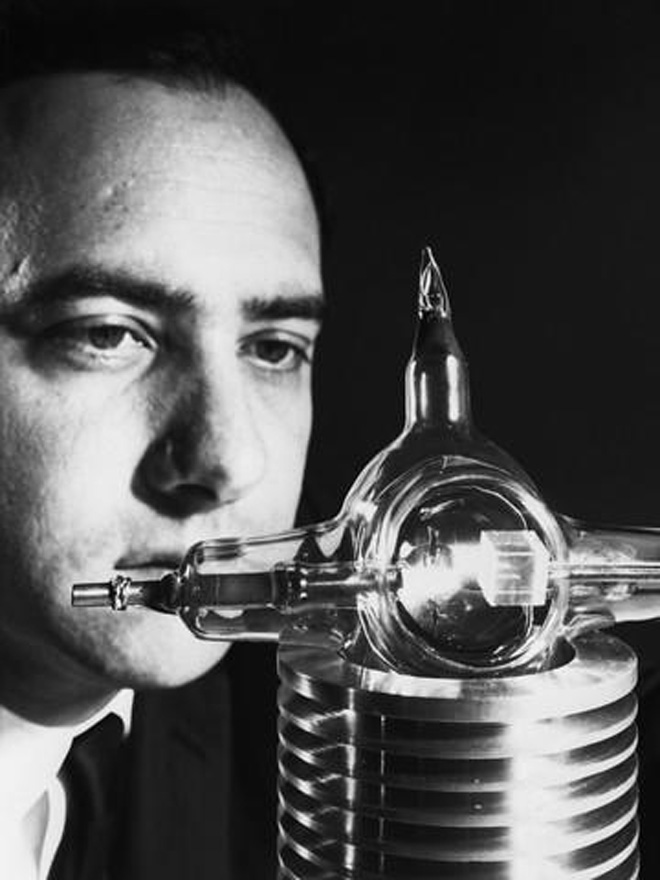A couple of days ago, I decided that I really needed a laser distance measurer (it’s best if you don’t ask questions), so I ambled down to my local Home Depot store and picked up a Bosch BLAZE device for only $29.
This little beauty, which is only 4 x 1.3 x 0.9” (10 x 3.3 x 2.3 cm) in size, can measure and record distances up to 65 feet (20 meters) with an accuracy of +/- 0.1” (3 mm) (I’ve rounded the numbers for simplicity).
The first thing that struck me was the user interface, which is classic in terms of usability. There’s only one button on the front of the device. You press-and-hold this button for a short time to turn it on. As soon as you turn it on, it continuously measures the distance to the nearest object in the direction in which it’s pointing and displays the result. By default, it presents distances in terms of feet and inches.
Once on, if you press the button for a short time, it locks the current value on the display, which can be useful when you are contorting yourself to measure certain spaces. Another short press returns you to the continuous measurement-and-display mode.
A long press-and-hold will turn the device off. Also, it will turn itself off five minutes after the last activity as a power-saving feature. Last but not least, when the device is off, a long press-and-hold will bring it up in a setup mode in which repeated short presses will cause it to cycle between different units (feet-and-inches, inches, and meters)
My next thought was to reflect on just how amazing this little scamp is. The acronym LASER stands for “Light Amplification by Stimulated Emission of Radiation,” but lasers have become so ubiquitous that we no longer capitalize this term. The first working laser was created in 1960 by American engineer and physicist Theodore Harold “Ted” Maiman working at Hughes Research Laboratories (HRL), which is now called HRL Laboratories.

Theodore Harold “Ted” Maiman with one of his early lasers (Image source: HRL Laboratories LLC)
At that time, lasers were humongously large, and they had a price tag that would make your eyes water and bring you to your knees. By the 1980s, laser pointers based on semiconductor laser diodes were available, but even these rudimentary devices cost hundreds of dollars. So, the fact that, for only $29, I can now purchase a device that uses a laser and a microprocessor to measure distances up to 65 feet with an accuracy of +/- 0.1” is pretty astounding
I wonder what Mr. Maiman would think if I could get my time machine to work and take my little laser distance measurer back to show him (unfortunately, I’ve lost one of my time machine’s wibbly-wobbly bits, and you simply can’t get the spare parts where — and when — I live).
The reason I’m waffling on about this here is that it makes me think just how much technology has changed since I was born. (This would be a good time for you to imagine “travelling back in time music and visual effects.”)
Deep in the Mists of Time
Not so long ago, I was talking to one of my friend’s little kids. As part of this conversation, I mentioned that when I was his age, one of my chores was to chase dinosaurs out of the family’s cabbage patch… and he didn’t blink an eye. I feel like an old fool (but where are we going to find one at this time of the day?).
My dad was born in 1915, which was which was about a third of the way through WWI and five years before the world’s first commercial radio broadcast (see The Times They Are a-Changin’ Part 3). My mom was born in 1930, which was nine years before the outbreak of WWII and five years before the first rudimentary radar system was tested in England (see The Times They Are a-Changin’ Part 1).
When my mom was growing up, they had one cold-water tap in the house. They used the coal-fired stove in the family room (there was no kitchen) to heat water for their weekly baths in the tin tub they dragged up from the cellar. Lighting was provided by gas mantles on the wall. They didn’t get electricity in the house until the middle of WWII, and that involved only one power socket in the family room, which they used to power a vacuum tube radio, and one electric light.
At the beginning of WWII, England’s long-range aircraft detection capabilities were based on a series of concrete parabolic acoustic mirrors that were located around the south coast of the country. A microphone was mounted at the focus point of the mirror. A listener would try to determine the distance and bearing of any incoming enemy aircraft. The listener would then hop on a bicycle and peddle furiously to the nearest village to make a phone call to alert military command. By the end of WWII, we had jet engines, bouncing bombs, radio navigation, radar, rockets, computers, and nuclear bombs (hurray for us!).

14’ 9” tall concrete acoustic mirror (Image source: Paul Glazzard/Wikipedia)
I was born in Sheffield, Yorkshire (God’s favorite county), England (God’s own country) in 1957, which was only 12 years after the last bullet was fired and the last bomb was dropped in WWII. When I was growing up, we had one small black-and-white vacuum tube television in the family room, and a black rotary-dial telephone hard-wired to the wall at the bottom of the staircase next to the front door.
In the case of the television, we had only two channels, and even they didn’t come on until around 4:00 p.m. in the afternoon. The television closed down in the evening after the “Ten O’Clock News” by playing the national anthem, for which everyone would stand (they also played the national anthem after a film had played at the cinema, and everyone stood for that). When we turned the television on, the picture gradually grew to fill the screen; when we turned it off again, the picture shrank until only a small dot remained. Furthermore, when the television was on, you typically had to spend an inordinate amount of time fiddling with the controls and the “rabbit ears” antennae to stabilize the picture.
We didn’t have much money when I was a kid. On Saturdays, my parents would take me to the town center, where we spent a happy time wandering around window shopping. I remember when I was about six years old circa 1963. We were meandering our way down the high street when we happened to pass a television display in the window of a large department store. There were black-and-white TVs of all shapes and sizes. In the center of the display, on its own, was a color television. My mind was boggled. I was flabbergasted (rarely had my flabber been so gasted). My parents and I stood there for ages with our mouths open and our noses pressed against the window.
Although it never really struck me at the time, there were a lot of black-and-white films about WWII on television in my formative years. (Now I come to think about it, these films may have been in color, but since we only had a black-and-white television that really wasn’t an issue). Even then, the technology depicted in the films seemed terribly old-fashioned. If I’d thought about it at all, I would have assumed that the period depicted in these films had occurred a long, long time in the past. It never struck me that WWII had occurred so close to when I decided to grace this planet with my presence.
Returning to the telephone… after WWII, one of my dad’s sisters married a Polish soldier, while another married a soldier from Czechoslovakia. Both of the sisters and their husbands emigrated to Edmonton Canada. My dad’s third sister, my auntie Barbara, lived up the road from us.
Throughout the 1960s, a few weeks before Christmas, auntie Barbara would come to our house, and she and my mom would call the telephone operator to place a call to Canada. The local operator would call the international operator in London; the international operator in London would call the international operator in Canada; the international operator in Canada would call the local operator in Edmonton; and the local operator in Edmonton would call one of my aunts.
There was no such thing as voicemail in those days, so if my aunt was out, they’d have to try again a few days later. Even if my aunt was in, this wasn’t “The Call”; this was just to set a day and time for the official Christmas call. On that fabulous day, the families in England would gather at our house, while the families in Canada would gather at the designated aunt’s house. At the appointed time, my dad would make the call, we’d all shout “Happy Christmas” to each other, and then we’d hang up quickly because international calls were expensive and we didn’t have a lot of spare cash. It wasn’t until around 1971 that folks could direct dial from England to North America, and vice versa.
I graduated high school in 1975. While I was a student at university, I saw an advert in an electronics hobbyist magazine for a simple single board computer (SBC). This little beauty had 2KB of ROM, 1KB of RAM, a hexadecimal keypad with some extra control buttons, and six 7-segment LED displays. Although it was only around 100 UK pounds (about $200 at that time), this was well outside my budget as a student. I remember thinking at that time that I would never be in a position to own my own computer.
In 1980, I graduated from university with a BSc in Control Engineering (I think they call it System Engineering now). My first position was at International Computers Limited (ICL) in West Gorton, Manchester. I was a member of a team designing central processing units (CPUs) for mainframe computers. At that time, computers really weren’t that sociable and didn’t like talking to each other. Things were so dire that if you purchased two IBM computers from different families, even they wouldn’t talk to each other to the extent that a text file created on one may well not be readable on the other.
Sometime circa the summer of 1981, using a proprietary network technology, ICL got a mainframe computer to talk to a small desktop computer. You could create a text file on one computer, save it, open it using the other computer, make changes, save the new version, then open it using the first computer again. Although this may not sound like much now, reporters from all the major newspapers came up from London to see it in action. (I can scarcely believe this myself as I write it – that this was such amazing news — but I was there and I saw it with my own eyes.)
The first cordless telephones arrived in the UK in the mid-1980s. One of my friends bought one. We all went around to his house to see it. We were used to having phones that were tied to the wall, so we were entranced by the fact that our friend could wander around the house while talking on the phone. Actually, he wasn’t talking, he was listening to the speaking clock, because everyone he knew to call was in his house watching him use his cordless phone (see also The Speaking Clock Speaks No More).
I moved to the US in 1990. In 1998, one of my friends, we’ll call him Alvin (because that’s his name) and I formed a little company. We had real jobs in the day, but we’d work out of our own office in the evenings. We both purchased tower computers with Intel Pentium processors running Windows 95. They didn’t have much memory and their hard disks had laughingly low capacity by today’s standards, but they still cost us around $2,400 apiece. The 56K modem had only just arrived on the scene, so we purchased one of these little beauties. Only one of us could use it at a time, and this involved pulling the cable out of the back of one computer and sticking it into the other. One evening when I arrived at the office, Alvin had just finished installing a new ISA card in his tower. This allowed the modem to be connected to his computer, and his computer to be connected to mine. Now, even though only one of us could use the modem at a time, we could take turns without unplugging any cables. We felt like we were at the cutting edge of technology and spent the rest of the evening high fiving each other
When mobile phones first arrived on the scene, they were incredibly expensive. As an alternative, we had pagers. (Did you know that the first pager-like system was used by the Detroit Police Department in 1921?) I was so proud when the company I was working for in the early 1990s deemed me to be important enough to be equipped with a pager. It was unfortunate that my pager number was only one digit different to a hair loss solutions company. Whenever they ran an advert on the local radio station, my pager started to “buzz off the hook.”
Eventually, mobile phones fell in price and size, and more and more people started to use them. The first commercial mobile phone to include a camera came on the market in Japan in 2000, followed by the USA in 2001. At that time, the vast majority of people said, “why would I want a camera in my phone – all I want to do with my phone is make calls.” The year 2000 doesn’t seem that long ago, but – at that time – no one I knew would have predicted today’s mobile phones with high-resolution cameras to take photos and videos, MP3 players, GPS, and all the other capabilities and functionalities they boast.
In a few days’ time, as I pen these words, it will be 2020, which means we will be 1/5th of the way through the 21st century. As I look around my home, I’m surrounded by computers of all shapes and sizes. We have multi-channel Wi-Fi in the house and a 500 mbps data connection to the outside world. Via the internet, we have access to a vast repository of information (data, images, videos, etc.), some of which is even useful. We have large, high-definition color televisions in the family room, the study, and the bedrooms.
In addition to a binocular vision system, my automobile (a Subaru CrossTrek) has more computer systems and capabilities than a small commercial aircraft of only a few years ago.
My dear old mother in England can use her cell phone to call me on my cell phone 24/7/365 (she tends to forget the 6-hour time difference, bless her little cotton socks). Via the various Amazon Echo devices scattered around the house, I can turn the lights on and off as I move from room to room, and I can also use voice commands to order things I don’t really want or need while basking in bed.
What does the future hold? I have no idea. As little as 40, 30, and even 20 years ago, I had no idea as to the types of technologies and the sophistication of those technologies we would have today. Based on this, I’ve come to the realization that I don’t really have a clue what the world will look like in 20, 30, or 40 years’ time, but I can’t wait to find out. How about you, what are your thoughts on all this?





